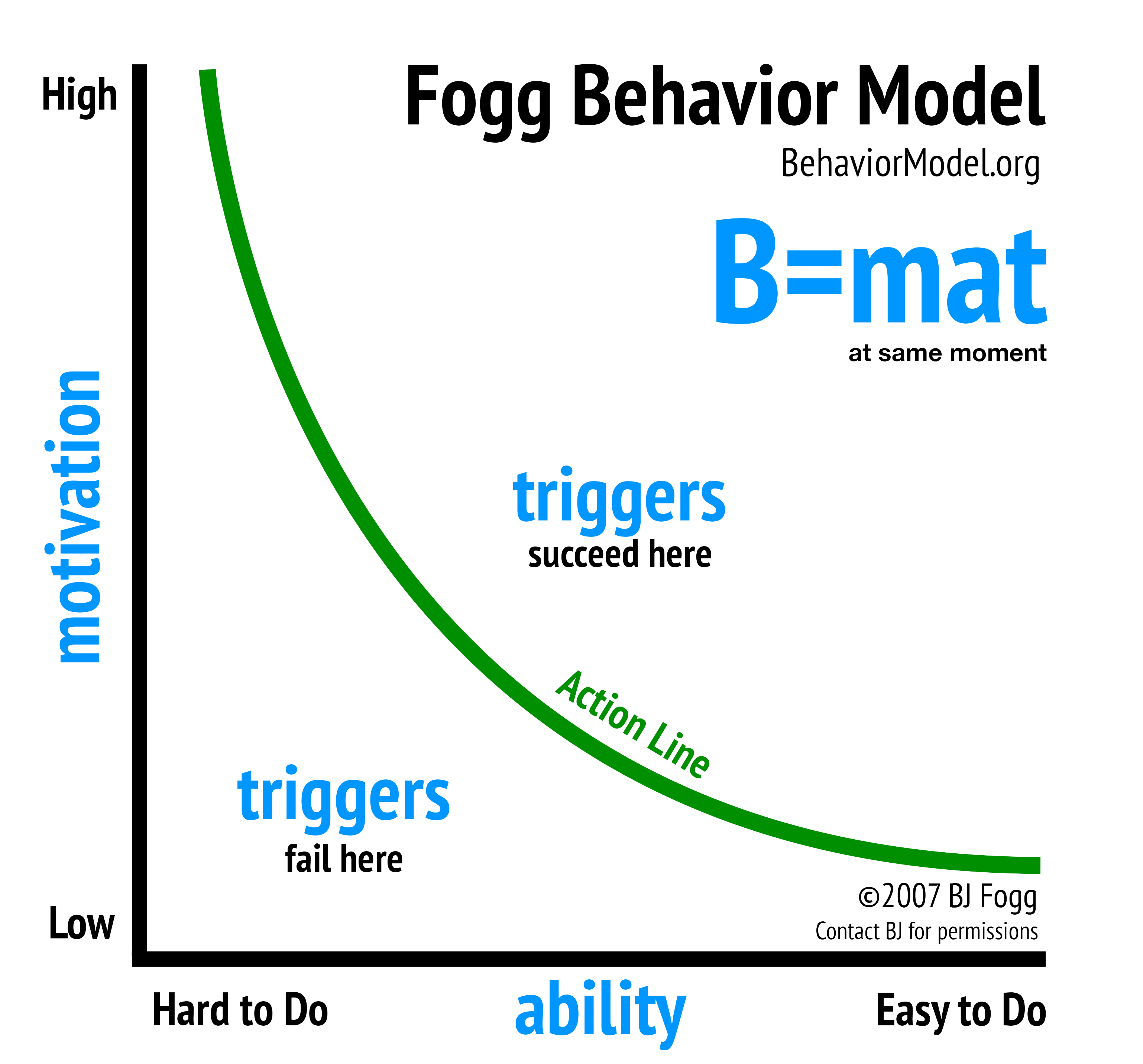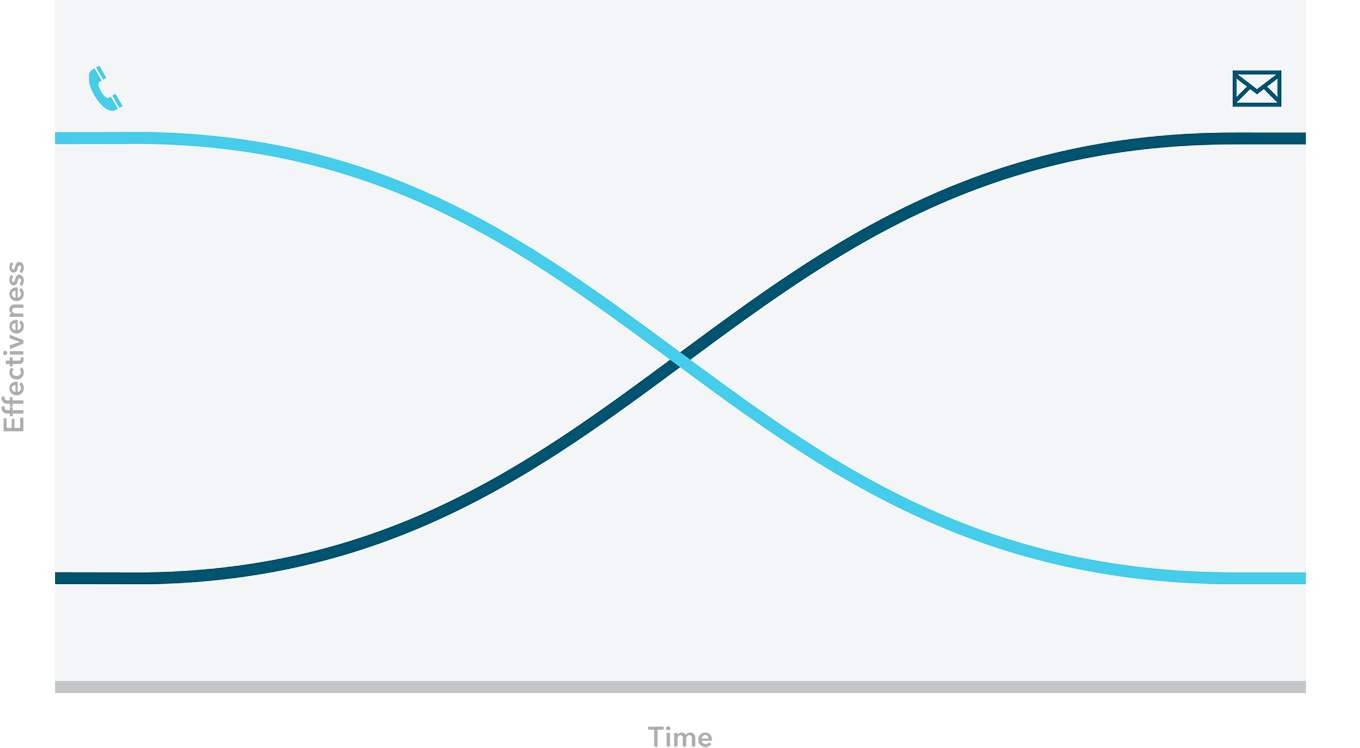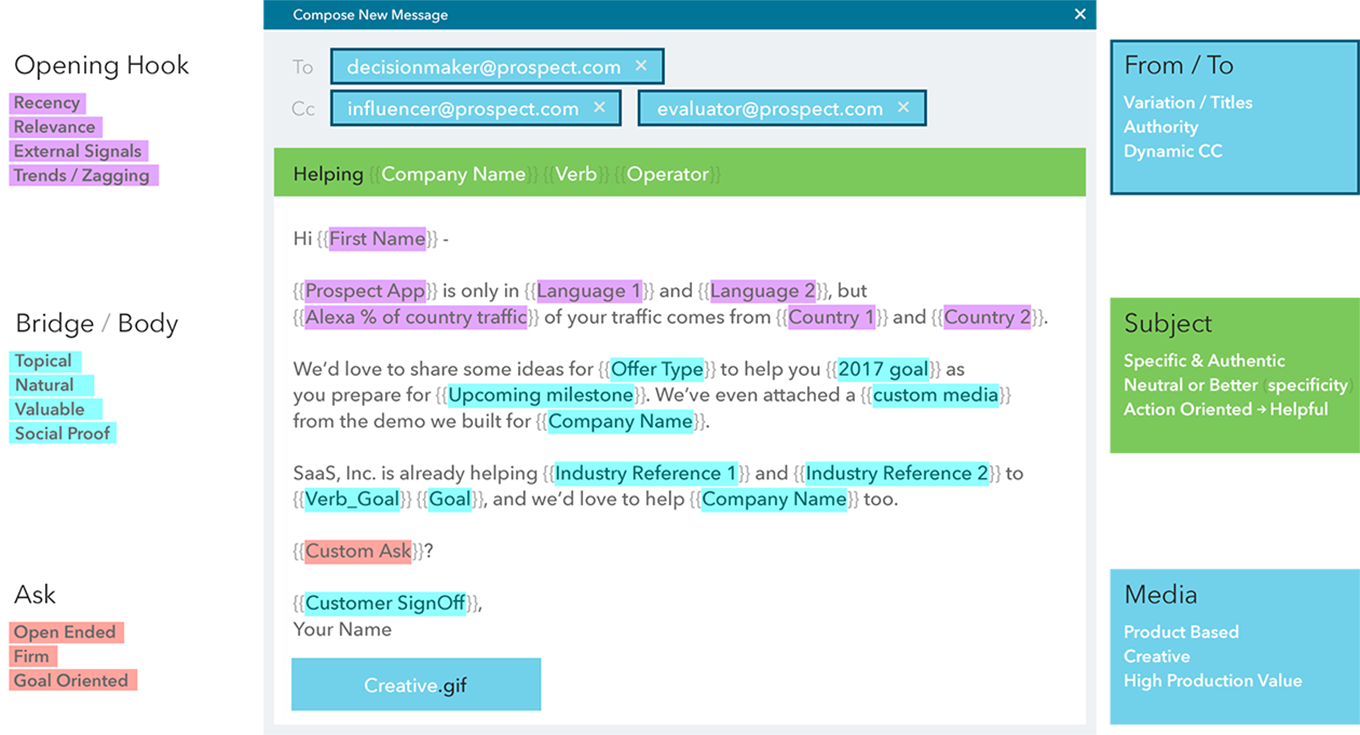Chapter 3
14 minutes
Outbound Sales Fundamentals


Ben Salzman & Kyle Williams Co-founders of Dogpatch Advisiors
In August 2009, I received an email that announced the launch of Google App Script, a product that introduced automation into the Google Apps product suite. Immediately, I sent a chat message to my coworker, Kyle Williams, a sales rep based out of Google’s Austin office.
“What does this mean for us?” I asked him, pasting in a link to the product announcement.
Seconds later he responded, “Already on it.”
Twenty years ago, Kyle wouldn’t have been a sales rep. He’s far too geeky (he’s one of my closest friends, so I reserve the right to say these things). But my technical friend represents a new breed of salespeople that are changing the technology industry, boosting profits, and slashing jobs en masse.
Our chat conversation, and the subsequent tools that we built, opened my eyes to this reality.
Days after Google App Scripts launched, Kyle built a script that allowed the rows and columns from his spreadsheet to feed into Gmail. “We can automate our email campaigns now,” he told me. At first I didn’t get it; marketing automation tools like Marketo had introduced scalable email years ago, and our entire sales team at Google could send email from Salesforce. By the end of our conversation, though, I realized that Kyle had stumbled upon a small nuance that might have a huge impact on our sales funnel.
The problem with automation, he explained, was that it was immediately recognizable to the recipient as a marketing email. The lack of personalization meant that prospects felt no incentive to respond, let alone agree to a meeting. But automation has its obvious benefits: compared to the single-digit-per-hour emails that a human can send, automation enabled scale. With his new script, Kyle wanted to have his cake and eat it too. The first version made it possible to load data into a Google Sheet—for example, snippets like “I noticed that you use Lotus Notes”—and then pull that data into Gmail to send a semi-personalized email.
That fall, we began shopping the idea of a personalized outbound sales process around Google. While management was quietly supportive of the idea of scaling outreach, there was zero formal process or strategy. Most people didn’t want to be associated with the idea, seeing cold email as spam, and pointing us to marketing leadership for approval.
The feedback we got from management was, “We like this. But we don’t want to send generic, low-value messages and risk hurting our brand.”
Some of our earliest campaigns were sent to contacts (inbound leads) already in our database and centered around events, webinars, and other marketing- and sales-driven activities. These tests were wildly successful. We emailed hundreds of potential customers at once, swapping in words, phrases, and sentences relevant to the prospect, all driven by data. At that time, our benchmark for replies from one-off outbound email hovered around 30%. These emails were performing at around 30%, but the volume was 10–100x our previous outbound efforts. All of this without the involvement of customer relationship management (CRM), marketing, or fluffy HTML templates.
But we ran into problems quickly. As we turned our targets from classic field marketing to new deal creation and cold outbound prospecting, we quickly identified two major roadblocks to ramping this up. First, most sales emails were focused solely on products or features. But any attempt we made to personalize them and make them less “salesy” were difficult to scale. In other words, we didn’t have a repeatable framework for creating valuable content that we could scale without human input.
The second problem was related to data. At the time (and this is still largely the case), data providers like Jigsaw and Hoovers only provided contact data and rudimentary attribute data. In other words, we could buy massive lists of emails and their associated geography or industry, but nothing more.
What we really wanted was “proxy data.”
We wanted to know useful information, like what types of technology a company used, so that we could change our messaging accordingly. For example, whether a company uses Microsoft Office or Lotus Notes is an indicator of their culture and the types of messages they might respond to.
Later that year, Kyle and I attended a sales training workshop at Google’s Austin office. The outside trainer broke down the fundamentals of creating value through cold emails. With his method, he said, we could see reply rates at or above 50%. The only problem? He suggested writing the emails by hand.
At the lunch break, I pulled Kyle aside. We immediately agreed this training was not only valuable, but transformative. If we could combine the sales trainer’s strategy for personalized hooks and content with the sending tool, we could far exceed our quotas, and build a powerful tool in the process.
Later that afternoon, Kyle and I spent two hours in a conference room furiously whiteboarding ideas for personalized outbound at scale. The outcome of this meeting was simple agreement on the three things necessary for high-performing outbound at scale in this new world:
- Large volumes of data about companies and people.
- High quality copy/content relevant for the prospect.
- Product that solves a real problem in a large market.
At the end of our meeting, we realized we were missing a key piece. While we understood our messaging strategy, we didn’t have a strategic way of thinking about the behavior we were aiming to drive. We needed a behavior framework to drive our messaging. Fortunately, right as we were looking for a framework, a scientist at Stanford’s Persuasive Technology Lab was developing exactly what we needed.
In 2009, BJ Fogg published a paper that proved for any behavior to happen, sufficient motivation and ability must exist with the presence of a trigger. And those triggers would be different based on someone’s situation. For example, a lower level manager might have high motivation (lots of pain/cost implications) but limited ability. A senior vice president (SVP) might have the ability, but not realize there’s a problem. After reading this paper, Kyle and I asked ourselves: What if we could map motivation and ability for each prospect and allow that to inform our call-to-action (a.k.a. trigger type)?

In September 2009, with a new goal in mind, Kyle built a script that could ping email servers to identify which email security vendor they used. This allowed us to target messaging based on the type of IT team that was likely to purchase that technology. For example, IronPort customers tended to have concerns about reliability, while open source users tended to have a management issue and be concerned about total cost of ownership.
As we ramped up our campaigns, opportunities came quickly. We broke into new accounts, unstuck deals, and filled seats at events faster and easier than ever before. Some campaigns produced 70% open rates and 20% first meeting rates.
As a result, our small team was beating teams two and three times our size in terms of sales efficiency and pipeline creation.
But with each success came a new problem to solve. As we began scaling the program, we realized we were spending most of our time preparing lists, cleaning data, and manipulating data. We agreed that in order to scale, individual sales reps couldn’t be stuck with these data janitor tasks. And thus, we invented the function of Outbound Operations to solve this problem. It wasn’t until our next company that we formalized the processes and structures and found a way to create $30 million in pipeline without Google’s cash and brand behind us.
How we invented the Outbound Operations function
Over the five years since we left Google, Kyle and I have helped dozens of companies build Outbound Operations into their organizations. In the rest of this chapter, we’ll share what we learned and how you can build this function into your company.
In July 2013, I joined an enterprise software startup, Kahuna, as the fifth employee. I was brought in to manage one salesperson, and tasked with building the team and helping close deals along the way. Our CEO also set a target of generating $1 million in new, qualified opportunities per quarter. My job was to replicate the process I helped pioneer at Google—with a fraction of the resources.
While confident that some version of Outbound Ops would fit, I was nervous about promising fast results without testing this outside of Google. When I broke down this process to our CEO, initially he wasn’t sold on the idea of “email blasts.” He was convinced that one-off, handcrafted emails would outperform any scalable solution. As we debated, we realized we had the same criteria for success: we wanted extreme personalization and we wanted lots of new opportunities. While most sales organizations achieve one of these two, few achieve both. Outbound Ops, I explained, is designed to avoid the false choice between personalization and scale.
Our early results were phenomenal. We scheduled calls with Kayak, Yahoo, the New York Times, and other premier brands immediately, despite having no brand recognition. But after a couple of months, we decided that things were moving too slowly. Our sales team was not technical, and often got bogged down with the mundane task of cleaning data. We needed someone to run the entire outbound sales strategy, from data collection to opportunity creation. Without someone to manage the planning process, shepherd these data workstreams, and implement a rigorous testing and iteration framework, we’d never see the results I’d seen at Google. Fortunately, Kyle came to the rescue when he joined as the company’s 10th employee.
After seeing the success of leveraging “proxy data,” Kyle suggested that we identify which technologies our ideal customers were using in their mobile apps. If we could understand which apps had competitive software development kits (SDKs) installed, we could personalize messaging based on weaknesses for each of the incumbent vendors. To address this, he wrote a program with Charles Proxy to sniff his own Wi-Fi traffic as each app downloaded to his iPad. Four hours later, we had the data on which apps had installed which SDKs for the top 1,000 apps on our target list.
This data allowed us to run large outbound campaigns with precision, personalizing content to all 1,000 accounts, specifically referencing shortfalls in their existing solution, and customizing our content based on seniority and vertical. Our average reply rate was 50% and our average first meeting rate was 20%. That first quarter, we exceeded the $1 million target our CEO set by a factor of three.
With a couple of wins behind us, the executive team gave us free reign to scale the team. At the time, the conventional wisdom said we should hire a handful of college graduates as sales development representatives (SDRs). By 2013, everyone in Silicon Valley was praising Aaron Ross’s Predictable Revenue, which first introduced the concept a couple of years before. But something about this strategy didn’t sit well with us. Why hire five people to do work that Kyle could automate in a few Red Bull-fueled nights? Unsure of our bold idea, we decided to take a hybrid approach. Kyle would build automation systems to supercharge the workflow of one or two reps.
When we initially wrote the job descriptions, we agreed to look for two traits in candidates. First, we would look for people with strong written communication skills. Whereas phone skills (cold calling and sales scripts) used to be the only prerequisite for an inside sales representative, we felt that the ability to inspire behavior through emails was far more important. Second, we wanted sales professionals who thought strategically about how to leverage data in campaigns—more Nate Silver-style quant, less country club schmoozer.

As we interviewed potential SDRs, we found plenty of good writers, but very few candidates knew their way around a spreadsheet. We’d ask them to rate their Excel skills; they’d respond “above average,” and then we’d test them and watch as they struggled to use the filter function. It wasn’t until we took the problem to our operations lead, Amy, that we realized we were fishing in the wrong waters.
After we explained our criteria to her, she asked something novel: what if we broke down the sales roles and had reps only focus on copy and strategy, and never touching raw data? She offered to help run data work streams so that reps could focus on customized copy and hooks in the emails. Whereas the average SDR might spend an entire day building a list of 100 sales leads, a strong operations hire can leverage scripts and other forms of automation to build a list ten times the size in half the time. Just as specialization of labor built our complex society, we were using it to generate deals like never before.

After a couple of quarters of strong results, we learned that the Outbound Operations team should be responsible for four activities: campaign planning, data cleansing, data and campaign review, and rigorous analytics.
Campaign planning
We learned very early on that the highest performing campaigns were the ones that evolved from carefully planned and discussed strategies. Rather than haphazardly trying to plan and execute each campaign on the same day, we set up a weekly campaign planning meeting, where we’d tap the brains of our team’s smartest marketers, salespeople, and executives.
While it wasn’t evident initially, we learned that some of the behavioral triggers we so desperately wanted were locked up in the heads of our coworkers. Over lunch one day, a product marketer told me they had just finished A/B testing which website copy performs best by persona. She then asked why this data wouldn’t directly inform our outbound messaging. She was right. After that, I decided that we needed to formalize this knowledge sharing.
Data cleansing
Another early insight was how often an email would go out that looked something like this: “Hi JONES, I noticed you work at Twitter, INC.” These types of face-palm moments that outed our emails as impersonal were a result of sloppy data collection and cleansing.
After one of these emails went to our CEO’s best friend, we decided that we needed a formal process to solve this problem. We decided that sales reps would no longer touch data. Instead, a dedicated Outbound Operations team member would clean each spreadsheet before it went to the next stage.
Data and campaign review
Even after we formalized the data cleansing process, we still had a few face-palm moments. In one instance, an SDR emailed a nonexecutive board member at Priceline and misspelled his name. From that, we learned that a formal campaign audit was necessary.
Before each message (email copy) went into an active workflow, we sent it to our marketing department’s leadership for approval. This prevented silly mistakes and off-brand messaging by overeager salespeople.
Rigorous analytics
The most important thing we added to the Outbound Operations process was a formalized analytics system. After talking to some of our salespeople, we learned that many of them lacked the statistical knowledge to run proper A/B tests. Many of them would try a subject line on ten emails and then ditch it for a proven one. In other cases, representatives would put all their eggs in one basket and fail to produce any pipeline, thanks to a bad test.
To achieve constantly improving results, we gave analytics responsibility to one employee instead of leaving salespeople to their own devices. Housing analytics in one place helped us smooth out revenue growth. It also gave us the ability to store our learnings in a central repository, as opposed to a half-dozen people’s brains.

The results from our new Outbound Operations method were astounding. At the end of the first official year, the outbound sales team had generated $30 million in pipeline. That year, 75% of the revenue we booked came from our program.
In the time since we set up the Outbound Operations team at Kahuna, Kyle and I both left to start our own company. In doing so, we’ve had conversations with dozens of sales leaders about what we’ve learned. The reception ranges from skeptical to exuberant. But one thing is certain. Most teams—inspired by Aaron Ross’s Predictable Revenue—have implemented a sales process that is almost ten years old now. Meanwhile, the explosion of publicly available data and technology to make sense of it all has opened up new opportunities that the old playbook isn’t fit to leverage. Real-time APIs, scripts, and SQL databases are the types of concepts that will make a salesperson’s head spin. But they are the language of the day.
While we couldn’t have predicted it back in 2009 at Google, what Kyle stumbled upon that August day foreshadowed a shift that will have huge implications. Whereas the specialization first taught in Predictable Revenue was an important predecessor of this shift, most sales leaders have missed the point: technology isn’t changing the role of salespeople; it’s making them increasingly obsolete. While the salespeople of my parent’s generation schmoozed and boozed their clients over country club dinners, the quants replacing them are writing scripts and building widgets that generate 10 times the new business with half the people.

